Pure Mission – NAB 2018 Highlights New Hardware, Tools for Video Creatives
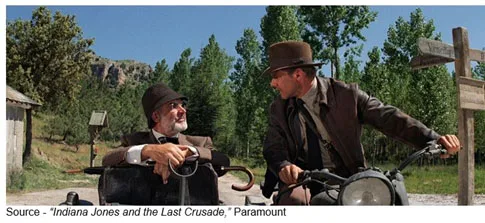
There are two parts of NAB – showcasing the tools for telling great video stories and, in recent years, addressing the challenge of figuring out how to distribute/monetize those stories.
Since the pre- through post-production equipment, products, tools and services are where all the magic takes place by shooters, audio and video editors, colorists and other skilled specialists; we’ll look at what was most exciting/promising here first. Later, we’ll look at the wild changes taking place in delivering the content to the consumers’ screen(s).
The best thing about this year’s NAB was the fun stuff got more fun, the cool gear was cooler, and the smart production software was smarter—and, the solutions are becoming easier, more reliable, easier to use and more economic.
We don’t think anyone had the nerve to talk about anything less than 4K; and they quickly added that HDR is available if you want it. More than a few gave attendees a peek at tomorrow’s 8K, 12K and 16K content for when we can figure out how to stream it properly.
And, with the recent release of Steven Spielberg’s Ready Player One film, VR (virtual reality) received an increased amount of attention. It’s becoming apparent that the nascent immersive experience is getting better and better.
There are still plenty of folks in the industry that say AR will become the winner, but we ran into Bob O’Donnell, president of TECHnalysis Research, at the show and he disagreed.
“We just completed a consumer study,” he noted, “and full immersion VR – not the 360 viewing many call VR – is driving the most interest and excitement among consumers by a factor of 3:1.
“People know its still the early days for the technology,” O’Donnell added, “but those who have tried it were satisfied with the experience and feel the products will get easier to use and the visual experience is rapidly getting better.”
Before NAB, we had a chance to peek at some advanced work and projects being done by some great pioneering shooters; and the stuff that will be released later this year and beyond will convince even the most skeptical out there.
At the show, we caught up with Phil Holland; who was demonstrating a bleeding-edge production system that included an advanced Asus motherboard, Nvidia GPU card and OWC SSDs designed to handle 12K, 16K and VR without choking.
He said VR is ready to come out of it’s cocoon and break the barrier between us and the content.
Holland noted people like Andrew MacDonald at Cream, Nick Bicanic, and people we’ll discuss later are refining new technologies and techniques that will make early VR experiences a thing of the past.
“VR and 360 video need to get to place where we have 4K through 8K resolution per eye so it becomes truly immersive,” he said. “The key will be new display technology that will increase the pixel count and avoid the ‘screen door effect’ experienced today.”
“The future of immersive visual experiences as well as practical workflow solutions,” Holland emphasized, “all point to larger capacity storage needs as well as faster storage to pull from particularly if you are editing native high resolution raw footage from digital cinema cameras or looking to explore uncompressed workflows. Low latency, fast RAID arrays deliver the performance we need working with ‘heavier’ materials.”
Right On!
But the fun part of NAB was about what people can use now!
Take Blackmagic.
I sometimes wonder if Grant Petty (CEO) and Dan May (president) aren’t hellbent on making Australia the center of the content production world.
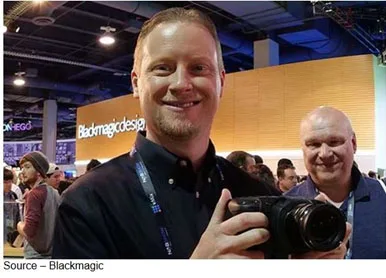
The refreshed Pocket Cinema Camera 4K packs a full-size, dual native ISO Micro Four Thirds sensor and can internally record 4K HDR RAW at 4,096 x 2,160 and 60 fps in 12-bit RAW or 10-bit ProRes.
It does all that and more for only $1,295–half the price of Panasonic’s GH5.
The carbon-fiber housing makes it light and easy to handle/use with a bigger grip and large array of physical dials/buttons.
For maximum field of view, it uses the full sensor width; and for better low-light performance (an issue in earlier models), has dual native ISO with a top setting of 25,600.
The 5-inch touchscreen seems brighter than the original and makes it easy to frame shots, check focus, adjust menu settings and add metadata.

There’s a lot to like about the camera (beyond the price), like recording ProRes and RAW on standard SD, UHS-II or CFast 2.0 cards; but we were more interested in the USB-C expansion port.
The port lets you connect lightweight, fast Thunderbolt 3 SSD storage so you can record hours of 4K content to a 1 or 2TB drive without stopping to swap cards. When you’re tired of holding the camera or done with the shoot, you can connect the drive to your computer and begin editing.
A real time saver!
But the Aussies weren’t a one-camera showoff. They have gear for the indie as well as the TV studio and film production lot.
When Petty said we just really enjoy making new products, he was probably only half-kidding.
They showed off a crazy array of cool production/post gear as well accessories for almost every task you can imagine.

Blackmagic just keeps making Resolve more useful.
Resolve 15 fully integrates visual effects and motion graphics, making it the first choice for online and offline editing, color correction, audio post, multi-user collaboration and visual effects … all in one software tool!
They added a new Fusion page with over 250 tools for compositing, paint, particles, animated titles and more, as well as updates to Fairlight audio and 100-plus features/improvements for pro editors, colorists.

What continually blows my mind though is that they obviously put a lot of hard work into making Resolve the gotta-have studio solution, but most of it is … free.
And if you just must have more advanced capabilities like collaboration, 3D and VR, added filters/effects, unlimited network rendering, temporal/spatial noise reduction, etc.; the cost is only $299 … chump change.
Best of all, you can do all of your work locally without worrying about internet or cloud issues.
When you’re done, use the cloud for your fourth copy!
There are times when working in the cloud is necessary, especially when you’re doing great collaborative work or need world class power tools.
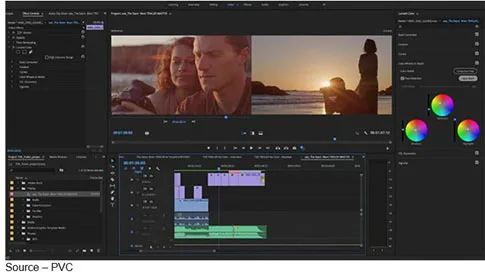
And this year, Adobe rolled out some great updates to the Creative Cloud Suite.
Their creative team delivered a beautiful family of tools to automate and speed up a lot of those time-consuming production tasks without sacrificing production quality and creative control.
The folks who really care about visual storytelling quality unveiled new capabilities for refining color, creating graphics and delivering mind-boggling audio.
And yes, they pushed us further into tomorrow with a lot of new and enhanced VR tools.
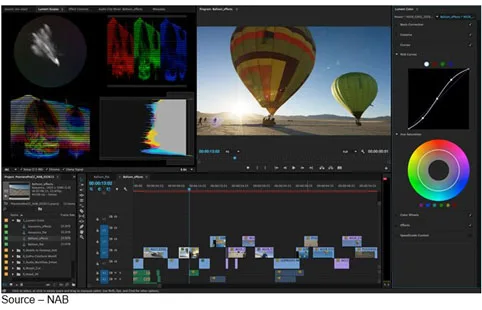
The new features and capabilities shown off at NAB included:
- Bringing color into the editing process at the outset with Lumerti tools including Color Match, so you can match shots with a single click, add editable color correction with another click and establish visual consistence in scenes, compare shots side-by-side or before/after wipes.
- Refine color and light as you edit giving every project its own cinematic look.
- Add impact with graphics and Adobe Stock and tools that let filmmakers and motion artists deliver beautiful imagery and graphics into their story.
- Using the new Advanced Puppet Engine, you can define precisely define organic movements.
- After the head of Allied Post showed me how important audio is to a production we’re glad to see Adobe beef-up the production quality of audio with Auto Ducking, Sensi and Audition CC. It’s a faster, more responsive audio editing environment with streamlined multitrack mixing (that’s really, really good).
For klutzs like us, the new Learn panel is just a click away … no excuse anymore!
With the release of ProRes RAW for Final Cut Pro X, Atomos leaped to the front of the line, building it into their recorders to show they’re ready and able to change tomorrow’s workflows.
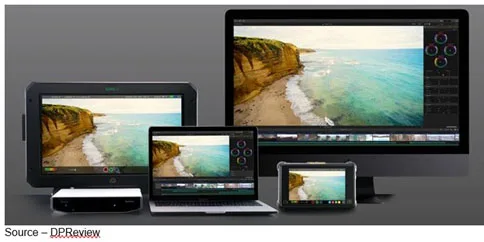
ProRes RAW combines the flexibility of RAW video with the performance of ProRes, so users can import, edit, grade video directly from the camera (currently Panasonic, Sony, Canon) without slowing down the edit.
Preserving every pixel, the RAW files should give users all the flexibility they need to extend brightness, shadow detail and deliver superb video.
And when you’ve stepped up to HDR projects, your videos will be more creative, more satisfying.
But nothing is more satisfying than really experiencing, really being part of the story; and the VR area (displays, sessions) of NAB was constantly packed as folks got inside of the progress that has been made in the past 12 months.
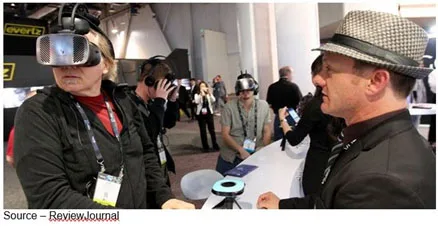
In between their respective demos and panel sessions, we caught up with Lewis Smithingham and Andrew Shulkind separately.
“We’re in the midst of a dramatic sea change in how we produce, view and experience content, said Smithingham. “We’re engaging with content differently and giving viewers a new experience by moving mobile first and streaming across the net. Too many people get hung up on the clunky headset look/feel and the projects we’re doing right now are way past that.”
Always the consummate professional, Shulkind emphasized that cinematic VR goes way beyond gaming by immersing the viewer in the film experience in ways no one thought was possible.
“We’re working on several hush-hush projects with major studios that will clearly show the possibility,” he stated. “We’ll be doing both live streaming VR and experiences that will launch new ways of creating, distributing and consuming/experiencing content.”
“We’re going to incorporate a new reality into stories, content and experiences,” he added. “We’ve made tremendous strides in cameras, lighting, special effects, production, editing and workflow in general; and boy, I wish I could tell you more but…”
Every time we talked to folks about the new cameras, array of post production tools for 4K HDR, 8K and VR; they all said they required lots of local working and backup storage.
Great!
Smithingham, Shulkind and numerous 4K, HDR filmmakers said they were anxious to get their hands on the new OWC ThunderBlade that would transfer data at up to 2800MB/s.
George Kennedy, of MagekFilmworks, stopped by the OWC booth to check out the compact, rugged 8TB unit and said, “In this business, the one thing we never have enough of is time. If I can move the content fast on the front-end; it means people all along the workflow have the time they need to do an even better job, faster. That can make a good visual story great.”
When he’s right … he’s right!
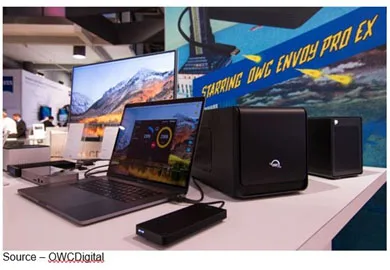
OWC’s ThunderBlade with up to 8TB of storage and 1, 2TB Envoy Pro EX with transfer rates up to 2600 MB/s got a lot of attention from shooters and production folks who never seem to have enough capacity or speed but the Helios FX eGPU drew a lot of “Oh Yeahs!” from Mac, PC notebook users.
You simply drop in almost any AMD or Nvidia GPU card and almost instantly, you can handle the toughest graphic processing to edit at greater resolutions, deliver smoother film rates and improve 4K, HDR, VR workflow.
The whisper-quiet unit with its Thunderbolt 3 interface delivers instant relief for people who like the flexible convenience of a light laptop for workflow processing but also need the power and performance of a desktop-class GPU.
Jamaican Twain Richardson, FoRPostProd, summed it best, “It will give me more beach time.”
We bumped into Dean Georgopoulos, one of the smartest DITs we know, in the OWC booth checking out the Envoy Pro EX and asked him about working and storage in the cloud.
“We can’t use the cloud because our files are too large,” he said. “With a typical day’s shoot, we’re capturing between 2-4TB of content. It simply isn’t practical to push that much content to the cloud. Even if it were and we had unlimited bandwidth up stream, we’d also have to have unlimited downstream bandwidth. It’s impractical and dangerous.”
“Unless you have a very secure, encrypted solution; we avoid using public clouds to place professional material from our shoots,” he continued.
“Netflix and studios accept a certain amount of streaming piracy, but project producers have to keep content local,” Georgopoulos emphasized. “The cloud is safe until it’s isn’t and then, it’s too late.”
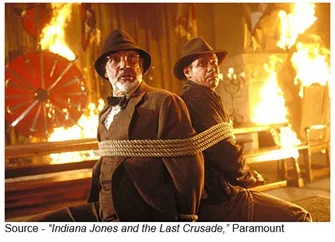 That’s probably about the time Professor Jones said, “You left, just as you were becoming interesting.”
That’s probably about the time Professor Jones said, “You left, just as you were becoming interesting.”
###